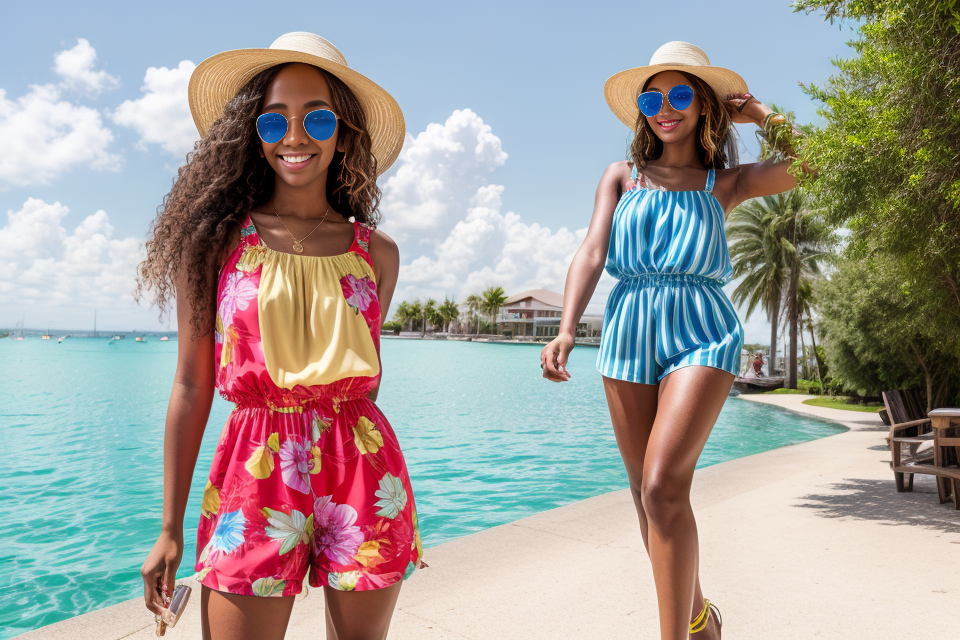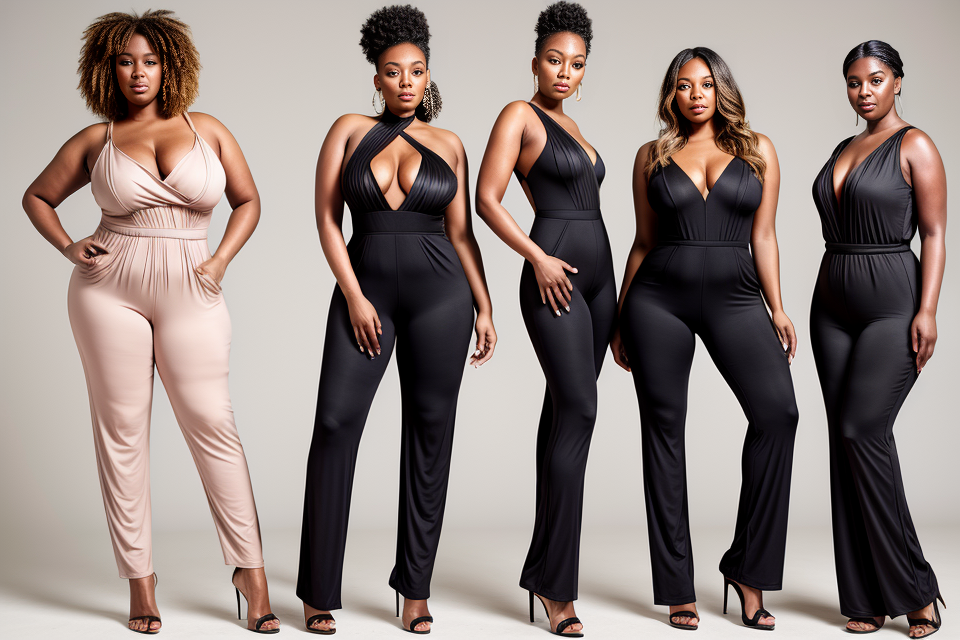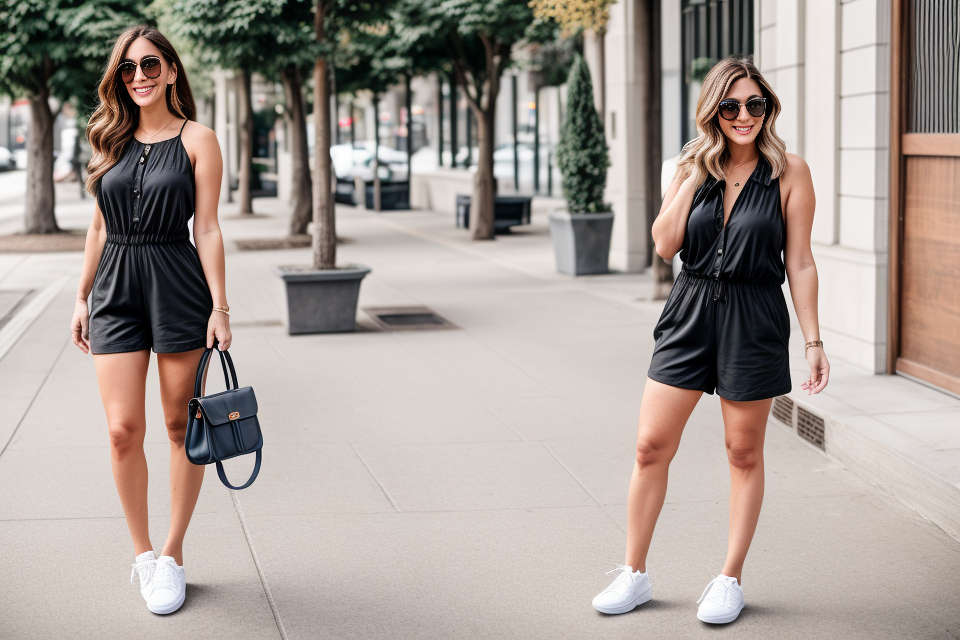Ah, the age-old question that has been plaguing fashion lovers for years. Is a romper the same as a bodysuit? It’s a topic that has sparked countless debates, arguments, and even fistfights (okay, maybe not the last one, but you get the point). So, what’s the real difference between these two garments? Well, we’re here to set the record straight and put an end to this great debate once and for all. Let’s dive in and find out what separates a romper from a bodysuit.
What is a Romper?
Definition and History
Origins of the Romper
The romper, also known as a onesie or jumpsuit, is a type of garment that has been around for many years. Its origins can be traced back to the early 20th century, where it was first worn by infants and toddlers. The romper was designed to be a convenient and practical outfit for young children who were still learning to walk and dress themselves. The one-piece design made it easy for them to move around and play without having to worry about their clothing coming undone or falling off.
Popularity and Versatility
Over the years, the romper has become a popular choice for adults as well as children. Its versatility and comfort have made it a popular option for casual wear, lounging around the house, and even as a uniform for certain professions such as chefs and pilots. The romper has also become a popular choice for special occasions such as Halloween costumes and cosplay outfits.
The romper’s popularity has grown due to its ability to provide both comfort and style. The garment’s simplicity and lack of complicated fastenings make it easy to put on and take off, while its wide range of designs and colors make it a versatile choice for any occasion. Whether worn as a casual outfit or as a formal uniform, the romper has become a wardrobe staple for many people.
Key Features of a Romper
A romper is a type of one-piece garment typically worn by children and infants. It is characterized by its one-piece design, which makes it easy to put on and take off. Rompers can be worn for various occasions, including for playtime, for sleeping, or as part of a uniform.
One-Piece Design
One of the most significant features of a romper is its one-piece design. This means that the garment is made in one piece, which includes the top and bottom parts. The one-piece design is convenient for parents who want to dress their children quickly and easily. It also ensures that the outfit stays in place, which is especially important for young children who are still learning to dress themselves.
Opening at the Bottom
Another key feature of a romper is the opening at the bottom. This opening is typically located at the crotch area and is often secured with snap buttons or a zipper. The opening at the bottom allows children to use the restroom easily without having to remove the entire romper. This feature is especially important for young children who may not have the dexterity to remove and replace their clothing quickly.
Short or Long Sleeves
Rompers can come with either short or long sleeves, depending on the design. Short sleeves are typically more common for infants and toddlers, while older children may prefer rompers with long sleeves. The sleeves can be made from a variety of materials, including cotton, polyester, or a blend of both. Some rompers may also have cuffs at the end of the sleeves to add a touch of style and keep the sleeves in place.
What is a Bodysuit?
Origins of the Bodysuit
The bodysuit is a form-fitting garment that covers the entire body, from the neck to the waist and the waist to the ankles. The term “bodysuit” has been used since the early 20th century, but the concept of the garment dates back much further.
In the 15th century, the doublet was a popular men’s garment that was worn as an outer layer over a shirt. The doublet was a close-fitting, sleeveless jacket that was often made of leather or heavy fabric, and it laced up the front with buttons or ties.
Women’s fashion also featured form-fitting garments during this time, such as the “pair of bodies” or “bodies.” These were two separate pieces that laced up the front and were worn over a chemise or shift.
Evolution of the Garment
The bodysuit has evolved significantly over the centuries, and it has been influenced by a variety of factors, including social and cultural changes, technological advancements, and fashion trends.
During the 19th century, the corset became a popular garment for women, and it was often worn as an undergarment to shape the body and create a cinched waist. The corset was a form of body shaping, and it was often worn with a dress or overcoat.
In the early 20th century, the corset was replaced by the brassiere, which was a more comfortable and practical undergarment for women. The brassiere was designed to support and shape the breasts, and it was made of elastic material that could be easily pulled on and off.
The bodysuit continued to evolve throughout the 20th century, and it became a popular garment for both men and women. The garment was often made of stretchy materials like jersey and spandex, and it was designed to be form-fitting and comfortable.
In recent years, the bodysuit has become a popular garment for lingerie and undergarments, and it is often worn as a sexy and provocative piece. The bodysuit has also been adopted by athletes and activewear enthusiasts, who appreciate the garment’s form-fitting design and compression properties.
Key Features of a Bodysuit
A bodysuit is a one-piece garment that covers the torso and legs, typically worn as an undergarment or as a layering piece in clothing. The key features of a bodysuit are as follows:
- One-Piece Design: A bodysuit is a single piece of clothing that covers the entire body, typically from the crotch to the neck. It is designed to be worn as a single garment, without the need for separate pieces such as a top and bottom.
- Closed or Open at the Bottom: The bottom of a bodysuit can be either closed or open. A closed bodysuit has a seam at the crotch, while an open bodysuit has a gap at the crotch that allows for easier access to the legs. The choice between a closed or open bodysuit depends on personal preference and the occasion for which it is being worn.
- Sleeves: A bodysuit can have short or long sleeves, depending on the design and purpose of the garment. Short sleeves are common for casual wear, while long sleeves are more appropriate for formal occasions. The sleeves can be fitted or loose, and may be designed to be tucked into the pants or left untucked.
The Differences Between Rompers and Bodysuits
Styling and Comfort
Fit and Movement
When it comes to fit and movement, rompers and bodysuits differ significantly. Rompers are typically designed to be loose-fitting and comfortable, making them ideal for casual wear or as part of a uniform. On the other hand, bodysuits are designed to be form-fitting and are often used as a layering piece under clothing or as a standalone garment for special occasions.
Materials and Textures
In terms of materials and textures, rompers and bodysuits also differ. Rompers are often made from lightweight, breathable fabrics such as cotton or linen, making them suitable for warmer weather. In contrast, bodysuits are often made from heavier, more structured fabrics such as denim or leather, making them suitable for cooler weather or as a statement piece.
Another key difference between rompers and bodysuits is the level of coverage they provide. Rompers typically cover the entire body, including the legs, while bodysuits usually only cover the torso and leave the legs exposed. This difference in coverage can have a significant impact on the overall style and functionality of each garment.
Overall, while rompers and bodysuits may share some similarities, they are distinct garments with different styling and comfort considerations.
Purpose and Occasion
When it comes to the purpose and occasion of rompers and bodysuits, there are some key differences to consider.
Casual vs. Formal
One of the most obvious differences between rompers and bodysuits is the level of formality they offer. Rompers are generally considered to be more casual than bodysuits, making them a better choice for a daytime event or a casual night out. Bodysuits, on the other hand, are often seen as more formal and are a popular choice for weddings, formal events, and other dressy occasions.
Seasonal Appropriateness
Another important factor to consider when comparing rompers and bodysuits is their seasonal appropriateness. Rompers are often made from lightweight fabrics that are perfect for warm weather, making them a popular choice for summer outings. Bodysuits, on the other hand, can be made from a variety of fabrics and are often worn year-round, making them a versatile choice for any season.
Ultimately, the purpose and occasion of a romper or bodysuit will depend on the individual’s personal style and the event they are attending. Whether you choose a romper or a bodysuit will depend on your personal preferences and the specific occasion you are attending.
Design and Construction
When it comes to the design and construction of rompers and bodysuits, there are several key differences to consider.
Opening Methods
One of the most obvious differences between rompers and bodysuits is the way they are opened. Rompers typically have buttons or zippers that run down the front of the garment, allowing for easy access to the diaper area. In contrast, bodysuits often have a snap crotch or overlapping panels that are secured with snaps or hooks and eyes.
Necklines
Another difference between rompers and bodysuits is the neckline. Rompers usually have a round neckline that is designed to lay flat against the neck, while bodysuits may have a variety of neckline styles, including scoop neck, sweetheart, or halter.
Length
The length of rompers and bodysuits can also vary. Rompers are typically designed to be shorts or shorts-style garments, with the bottoms ending at or above the knee. In contrast, bodysuits can be any length, from a tank top to a long-sleeved onesie.
Overall, while rompers and bodysuits may share some similarities in terms of their intended use and the materials they are made from, their design and construction are quite different.
Accessorizing and Mix-and-Matching
Rompers and bodysuits are both popular one-piece garments that provide ease and convenience for wearers. However, one key difference between the two lies in their ability to be accessorized and mixed-and-matched with other clothing items.
While both rompers and bodysuits can be worn on their own, the versatility of each piece varies. Rompers are often designed to be more casual and comfortable, making them an ideal choice for everyday wear. They can be dressed up or down depending on the occasion, but they may not be as appropriate for formal events.
On the other hand, bodysuits are more versatile and can be dressed up or down for various occasions. They can be worn with skirts, dress pants, or shorts, making them a popular choice for work or special events. Bodysuits can also be paired with a variety of footwear, from heels to sneakers, making them a highly adaptable piece in any wardrobe.
When it comes to accessorizing, rompers may be more limited in their options. They can be paired with a cardigan or denim jacket for a more casual look, or with a clutch and heels for a night out. However, they may not be as easily paired with hats, scarves, or other accessories due to their design.
Bodysuits, on the other hand, offer more opportunities for accessorizing. They can be paired with hats, scarves, belts, and jewelry, making them a more versatile option for layering and personalizing one’s style.
In conclusion, while both rompers and bodysuits can be worn on their own, the versatility of each piece varies. Rompers are more casual and may not be as appropriate for formal events, while bodysuits are more versatile and can be dressed up or down for various occasions. Additionally, bodysuits offer more opportunities for accessorizing and mixing-and-matching with other clothing items.
The Similarities Between Rompers and Bodysuits
Overlapping Features
One of the most striking similarities between rompers and bodysuits is their one-piece design. Both garments are designed to be worn as a single piece, with no need for additional layers or accessories. This seamless design makes them ideal for hot weather or for days when you want to avoid the hassle of layering and adjusting multiple pieces of clothing.
Another overlapping feature between rompers and bodysuits is their convenience and versatility. Both garments can be worn for a variety of occasions, from casual outings to formal events. They can be dressed up or down depending on the occasion, making them a popular choice for those who want to maintain a stylish yet practical wardrobe.
Additionally, both rompers and bodysuits are often designed to be figure-hugging, which can make them flattering and comfortable to wear. They can be worn by individuals of all shapes and sizes, and can help to create a streamlined, chic look.
Overall, the similarities between rompers and bodysuits are clear, with both garments offering a one-piece design, convenience, versatility, and a figure-hugging fit. However, there are also some key differences between the two garments that set them apart from one another.
Comfort and Functionality
One of the main similarities between rompers and bodysuits is their comfort and functionality. Both garments are designed to provide ease of dressing, making them ideal for busy individuals who want to look put-together without spending too much time getting ready.
Additionally, both rompers and bodysuits offer moisture-wicking properties, which help to keep the wearer cool and comfortable during hot weather. This feature is particularly useful for those who live in warmer climates or who engage in physical activities that cause them to sweat.
Furthermore, both rompers and bodysuits are designed to be easy to move around in, making them suitable for a variety of occasions. Whether you’re running errands, attending a social event, or simply lounging at home, these garments offer a comfortable and practical option for those who want to look and feel their best.
Overall, the combination of comfort and functionality makes rompers and bodysuits popular choices for people of all ages and lifestyles. Whether you’re looking for a comfortable and stylish outfit for a night out or a practical and easy-to-wear option for everyday use, these garments offer a great solution.
FAQs
1. What is a romper?
A romper is a one-piece garment that is typically worn by infants and young children. It is a type of jumpsuit that is designed to be easy to put on and take off, and it usually has short sleeves and legs.
2. What is a bodysuit?
A bodysuit is a type of undergarment that is worn by both men and women. It is typically made of a stretchy, breathable fabric such as cotton or spandex, and it is designed to be worn under clothing. Bodysuits are often worn as a base layer to provide support and shape, and they can also be used as a shaping garment to help smooth out the body.
3. Is a romper the same as a bodysuit?
No, a romper and a bodysuit are not the same thing. While both garments are one-piece and may be worn by infants and young children, they are designed for different purposes. A romper is typically worn as a standalone garment, while a bodysuit is worn as an undergarment or shaping garment. Additionally, a romper has short sleeves and legs, while a bodysuit is typically sleeveless and may have a closed or open crotch.
4. Can I wear a romper as a bodysuit?
No, a romper is not designed to be worn as a bodysuit. While the two garments may be similar in appearance, they are made of different materials and are designed for different purposes. A romper is typically made of lightweight, breathable fabric and is designed to be worn as a standalone garment, while a bodysuit is made of a stretchy, breathable fabric and is designed to be worn as an undergarment or shaping garment.
5. Can I wear a bodysuit as a romper?
No, a bodysuit is not designed to be worn as a romper. While the two garments may look similar, they are made of different materials and are designed for different purposes. A bodysuit is typically made of a stretchy, breathable fabric and is designed to be worn as an undergarment or shaping garment, while a romper is made of lightweight, breathable fabric and is designed to be worn as a standalone garment.



